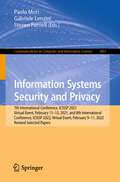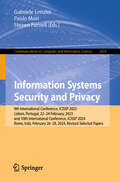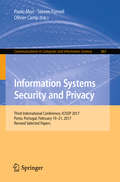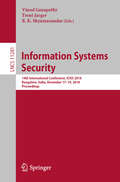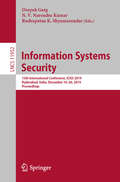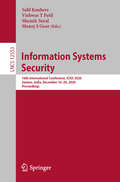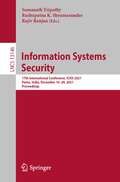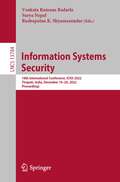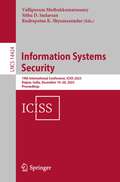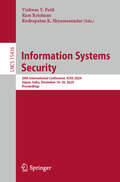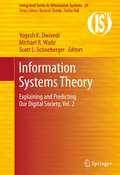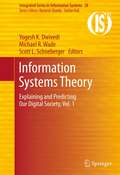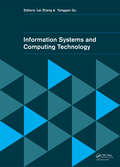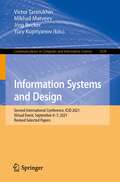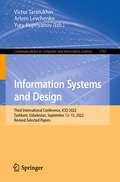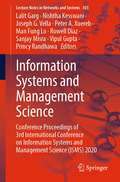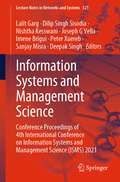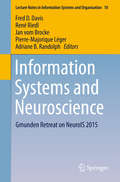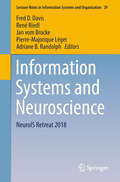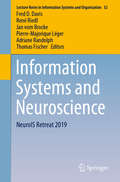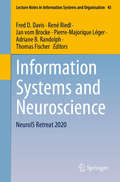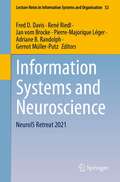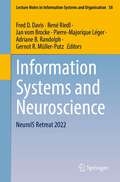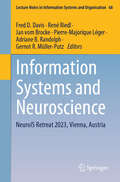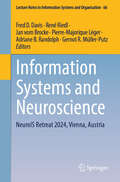- Table View
- List View
Information Systems Security and Privacy: 7th International Conference, ICISSP 2021, Virtual Event, February 11–13, 2021, and 8th International Conference, ICISSP 2022, Virtual Event, February 9–11, 2022, Revised Selected Papers (Communications in Computer and Information Science #1851)
by Steven Furnell Paolo Mori Gabriele LenziniThis book includes extended and revised versions of selected papers from the 7th and 8th edition of the International Conference on Information Systems Security and Privacy (ICISSP 2021 and ICISSP 2022). ICISSP 2021 and 2022 was held as an online event due to the Covid-19 pandemic, from February 11–13, 2021 and February 9–11, 2022. respectively.The 6 full papers included in this book were carefully reviewed and selected from 217 submissions. The ICISSP 2021 and 2022 book contains extended and revised version of proceedings papers dealing with information systems security and privacy.
Information Systems Security and Privacy: 9th International Conference, ICISSP 2023, Lisbon, Portugal, 22–24 February, 2023, and 10th International Conference, ICISSP 2024, Rome, Italy, February 26–28, 2024, Revised Selected Papers (Communications in Computer and Information Science #2459)
by Steven Furnell Paolo Mori Gabriele LenziniThis book constitutes the refereed post-proceedings of the 9th and 10th International Conference on Information Systems Security and Privacy, ICISSP 2023 and 2024, held in Lisbon, Portugal, and in Rome, Italy during February 22-24, 2023 and February 26-28, 2024, respectively. The 15 full papers included in this book were carefully reviewed and selected from 285 submissions. These papers have been organized under the following topical sections: Management and operations; Applications and services; and Technologies and foundations.
Information Systems Security and Privacy: Third International Conference, ICISSP 2017, Porto, Portugal, February 19-21, 2017, Revised Selected Papers (Communications in Computer and Information Science #867)
by Steven Furnell Olivier Camp Paolo MoriThis book constitutes the revised selected papers of the Third International Conference on Information Systems Security and Privacy, ICISSP 2017, held in Porto, Portugal, in February 2017. The 13 full papers presented were carefully reviewed and selected from a total of 100 submissions. They are dealing with topics such as vulnerability analysis and countermeasures, attack patterns discovery and intrusion detection, malware classification and detection, cryptography applications, data privacy and anonymization, security policy analysis, enhanced access control, and socio-technical aspects of security.
Information Systems Security: 14th International Conference, ICISS 2018, Bangalore, India, December 17-19, 2018, Proceedings (Lecture Notes in Computer Science #11281)
by Trent Jaeger Vinod Ganapathy R. K. ShyamasundarThis book constitutes the refereed proceedings of the 14th International Conference on Information Systems Security, ICISS 2018, held in Bangalore, India, in December 2018.The 23 revised full papers presented in this book together with 1 invited paper and 3 keynote abstracts were carefully reviewed and selected from 51 submissions. The papers are organized in the following topical sections: security for ubiquitous computing; modelling and anaylsis of attacks; smartphone security; cryptography and theory; enterprise and cloud security; machine learning and security; privacy; and client security and authentication.
Information Systems Security: 15th International Conference, ICISS 2019, Hyderabad, India, December 16–20, 2019, Proceedings (Lecture Notes in Computer Science #11952)
by Rudrapatna K. Shyamasundar Deepak Garg N. V. Narendra KumarThis book constitutes the proceedings of the 15th International Conference on Information Systems Security, ICISS 2019, held in Hyderabad, India, in December 2019.The 13 revised full papers and 4 short papers presented in this book together with 4 abstracts of invited talks were carefully reviewed and selected from 63 submissions.The papers cover topics such as: smart contracts; formal techniques; access control; machine learning; distributed systems; cryptography; online social networks; images and cryptography.
Information Systems Security: 16th International Conference, ICISS 2020, Jammu, India, December 16–20, 2020, Proceedings (Lecture Notes in Computer Science #12553)
by Salil Kanhere Vishwas T Patil Shamik Sural Manoj S GaurThis book constitutes the proceedings of the 16th International Conference on Information Systems Security, ICISS 2020, held in Jammu, India, during December 16-20, 2020.The 11 regular papers, 2 short papers and 3 work-in-progress papers included in this volume were carefully reviewed and selected from a total of 53 submissions. The papers were organized in topical sections named: access control; AI/ML in security; privacy and Web security; cryptography; and systems security.
Information Systems Security: 17th International Conference, ICISS 2021, Patna, India, December 16–20, 2021, Proceedings (Lecture Notes in Computer Science #13146)
by Rajiv Ranjan Rudrapatna K. Shyamasundar Somanath TripathyThis book constitutes the proceedings of the 17th International Conference on Information Systems Security, ICISS 2021, held in Patna, India, during December 16-20, 2021. The 9 regular papers, 2 short papers and 4 work-in-progress papers included in this volume were carefully reviewed and selected from a total of 48 submissions. The papers were organized in topical sections named: attack detection, malware identification, data security in distributed systems, and applied cryptography.
Information Systems Security: 18th International Conference, ICISS 2022, Tirupati, India, December 16–20, 2022, Proceedings (Lecture Notes in Computer Science #13784)
by Surya Nepal Rudrapatna K. Shyamasundar Venkata Ramana BadarlaThis book constitutes the refereed proceedings of the18th International Conference on Information Systems Security, ICISS 2022, held in Tirupati, India, during December 16–20, 2022The 8 full papers and 5 short papers included in this book were carefully reviewed and selected from 55 submissions. They were organized in topical sections as follows: ostinato: cross-host attack correlation through attack activity similaritydetection; DKS-PKI: a distributed key server architecture for public keyinfrastructure;generating-set evaluation of bloom filter hardening techniques in privaterecord linkage; etc
Information Systems Security: 19th International Conference, ICISS 2023, Raipur, India, December 16–20, 2023, Proceedings (Lecture Notes in Computer Science #14424)
by Rudrapatna K. Shyamasundar Vallipuram Muthukkumarasamy Sithu D. SudarsanThis book constitutes the refereed proceedings of the19th International Conference on Information Systems Security, ICISS 2023, held in Raipur, India, during December 16–20, 2023. The 18 full papers and 10 short papers included in this book were carefully reviewed and selected from 78 submissions. They are organized in topical sections as follows: systems security, network security, security in AI/ML, privacy, cryptography, blockchains.
Information Systems Security: 20th International Conference, ICISS 2024, Jaipur, India, December 16–20, 2024, Proceedings (Lecture Notes in Computer Science #15416)
by Rudrapatna K. Shyamasundar Ram Krishnan Vishwas T. PatilThis book constitutes the refereed proceedings of the 20th International Conference on Information Systems Security, ICISS 2024, held in Jaipur, India, during December 16–20, 2024. The 18 full papers and 6 short papers included in this book were carefully reviewed and selected from 93 submissions. They were organized in topical sections as follows: System Security; Network Security; Attack; Malware and Vulnerability Detection; Privacy & Usability; AI Security; and Industry Demo/Practice.
Information Systems Theory, Explaining and Predicting Our Digital Society, Vol. 2
by Yogesh K. Dwivedi Michael R. Wade Scott L. SchnebergerThe overall mission of this book is to provide a comprehensive understanding and coverage of the various theories and models used in IS research. Specifically, it aims to focus on the following key objectives: To describe the various theories and models applicable to studying IS/IT management issues. To outline and describe, for each of the various theories and models, independent and dependent constructs, reference discipline/originating area, originating author(s), seminal articles, level of analysis (i.e. firm, individual, industry) and links with other theories. To provide a critical review/meta-analysis of IS/IT management articles that have used a particular theory/model.To discuss how a theory can be used to better understand how information systems can be effectively deployed in today's digital world. This book contributes to our understanding of a number of theories and models. The theoretical contribution of this book is that it analyzes and synthesizes the relevant literature in order to enhance knowledge of IS theories and models from various perspectives. To cater to the information needs of a diverse spectrum of readers, this book is structured into two volumes, with each volume further broken down into two sections. The first section of Volume 1 presents detailed descriptions of a set of theories centered around the IS lifecycle, including the Success Model, Technology Acceptance Model, User Resistance Theories, and four others. The second section of Volume 1 contains strategic and economic theories, including a Resource-Based View, Theory of Slack Resources, Portfolio Theory, Discrepancy Theory Models, and eleven others. The first section of Volume 2 concerns socio-psychological theories. These include Personal Construct Theory, Psychological Ownership, Transactive Memory, Language-Action Approach, and nine others. The second section of Volume 2 deals with methodological theories, including Critical Realism, Grounded Theory, Narrative Inquiry, Work System Method, and four others. Together, these theories provide a rich tapestry of knowledge around the use of theory in IS research. Since most of these theories are from contributing disciplines, they provide a window into the world of external thought leadership.
Information Systems Theory: Explaining and Predicting Our Digital Society, Vol. 1
by Yogesh K. Dwivedi Michael R. Wade Scott L. SchnebergerThe overall mission of this book is to provide a comprehensive understanding and coverage of the various theories and models used in IS research. Specifically, it aims to focus on the following key objectives: To describe the various theories and models applicable to studying IS/IT management issues. To outline and describe, for each of the various theories and models, independent and dependent constructs, reference discipline/originating area, originating author(s), seminal articles, level of analysis (i.e. firm, individual, industry) and links with other theories. To provide a critical review/meta-analysis of IS/IT management articles that have used a particular theory/model.To discuss how a theory can be used to better understand how information systems can be effectively deployed in today's digital world. This book contributes to our understanding of a number of theories and models. The theoretical contribution of this book is that it analyzes and synthesizes the relevant literature in order to enhance knowledge of IS theories and models from various perspectives. To cater to the information needs of a diverse spectrum of readers, this book is structured into two volumes, with each volume further broken down into two sections. The first section of Volume 1 presents detailed descriptions of a set of theories centered around the IS lifecycle, including the Success Model, Technology Acceptance Model, User Resistance Theories, and four others. The second section of Volume 1 contains strategic and economic theories, including a Resource-Based View, Theory of Slack Resources, Portfolio Theory, Discrepancy Theory Models, and eleven others. The first section of Volume 2 concerns socio-psychological theories. These include Personal Construct Theory, Psychological Ownership, Transactive Memory, Language-Action Approach, and nine others. The second section of Volume 2 deals with methodological theories, including Critical Realism, Grounded Theory, Narrative Inquiry, Work System Method, and four others. Together, these theories provide a rich tapestry of knowledge around the use of theory in IS research. Since most of these theories are from contributing disciplines, they provide a window into the world of external thought leadership.
Information Systems and Computing Technology
by Lei Zhang Yonggen GuInformation systems are complex, including data collecting, storing, processing and delivering. The main components of information systems are computer hardware and software, telecommunications, databases and data warehouses, human resources, and procedures. With the development of information systems, the innovation technologies and their applicat
Information Systems and Design: Second International Conference, ICID 2021, Virtual Event, September 6–7, 2021, Revised Selected Papers (Communications in Computer and Information Science #1539)
by Jörg Becker Victor Taratukhin Mikhail Matveev Yury KupriyanovThis volume constitutes selected papers from the Second International Conference on Information Systems and Design, ICID 2021, held as virtual event in September 2021. The 24 full papers and 4 short papers presented were thoroughly reviewed and selected from 51 submissions. They are organized in topical sections on digital transformation of enterprises based on analysis and management tools: practical-focused research; methodological support of analysis and management tools: theoretical-focused research; young scientists research in the areas of enterprise digitalization.
Information Systems and Design: Third International Conference, ICID 2022, Tashkent, Uzbekistan, September 12–13, 2022, Revised Selected Papers (Communications in Computer and Information Science #1767)
by Victor Taratukhin Yury Kupriyanov Artem LevchenkoThis book constitutes the proceedings of Third International Conference on Information Systems and Design, ICID 2022, which took place in Tashkent, Uzbekistan, in September 2022. The 12 papers presented in this volume were carefully reviewed and selected from 35 submissions. They were organized in topical sections as follows: methodological support of analysis and management tools: theoretical-focused research; and digital transformation of enterprises based on analysis and management tools: practical-focused research.
Information Systems and Management Science: Conference Proceedings of 3rd International Conference on Information Systems and Management Science (ISMS) 2020 (Lecture Notes in Networks and Systems #303)
by Sanjay Misra Vipul Gupta Lalit Garg Nishtha Kesswani Joseph G. Vella Peter A. Xuereb Man Fung Lo Rowell Diaz Princy RandhawaThe book introduces concepts, principles, methods and procedures that will be valuable to students and scholars in thinking about existing organization systems, proposing new systems and working with management professionals in implementing new information systems. This book of Information Systems and Management Science (proceedings of ISMS 2020) is intended to be used as a reference by students and researchers who collect scientific and technical contributions with respect to models, tools, technologies and applications in the field of information systems and management science. This textbook shows how to exploit information systems in a technology-rich management field.
Information Systems and Management Science: Conference Proceedings of 4th International Conference on Information Systems and Management Science (ISMS) 2021 (Lecture Notes in Networks and Systems #521)
by Sanjay Misra Deepak Singh Lalit Garg Nishtha Kesswani Imene Brigui Dilip Singh Sisodia Joseph G Vella Peter XuerebThis multidisciplinary book delves into information systems’ concepts, principles, methods and procedures and their innovative applications in management science and other domains, including business, industry, health care and education. It will be valuable to students, researchers, academicians, developers, policymakers and managers thriving to improve their information and management systems, develop new strategies to solve complex problems and implement novel techniques to utilise the massive data best. This book of Information Systems and Management Science (proceedings of ISMS 2021) is intended to be used as a reference by scholars, scientists and practitioners who collect scientific and technical contributions concerning models, tools, technologies and applications in the field of information systems and management science. This book shows how to exploit information systems in a technology-rich management field.
Information Systems and Neuroscience
by Jan Vom Brocke René Riedl Pierre-Majorique Léger Fred D. Davis Adriane B. RandolphThis book presents the proceedings of the Gmunden Retreat on NeuroIS 2015, reporting on topics at the intersection of Information Systems (IS) research, neurophysiology and the brain sciences. Readers will discover the latest findings from top scholars in the field of NeuroIS, which offer detailed insights on the neurobiology underlying IS behavior, essential methods and tools and their applications for IS, as well as the application of neuroscience and neurophysiological theories to advance IS theory.
Information Systems and Neuroscience: Gmunden Retreat On Neurois 2016 (Lecture Notes in Information Systems and Organisation #16)
by Jan Vom Brocke René Riedl Pierre-Majorique Léger Fred D. Davis Adriane B. RandolphThis book presents the proceedings of the NeuroIS Retreat 2018, June 19-21, Vienna, Austria, reporting on topics at the intersection of Information Systems (IS) research, neurophysiology and the brain sciences. Readers will discover the latest findings from top scholars in the field of NeuroIS, which offer detailed insights on the neurobiology underlying IS behavior, essential methods and tools and their applications for IS, as well as the application of neuroscience and neurophysiological theories to advance IS theory.
Information Systems and Neuroscience: NeuroIS Retreat 2019 (Lecture Notes in Information Systems and Organisation #32)
by Thomas Fischer Jan Vom Brocke René Riedl Pierre-Majorique Léger Fred D. Davis Adriane RandolphThis book presents the proceedings of the NeuroIS Retreat 2019, held on June 4–6 in Vienna, Austria, reporting on topics at the intersection of information systems (IS) research, neurophysiology and the brain sciences. Featuring the latest findings from top scholars in the field, it offers detailed insights into the neurobiology underlying IS behavior, essential methods and tools and their applications for IS, as well as applying neuroscience and neurophysiological to advance IS theory.
Information Systems and Neuroscience: NeuroIS Retreat 2020 (Lecture Notes in Information Systems and Organisation #43)
by Thomas Fischer Jan Vom Brocke René Riedl Pierre-Majorique Léger Fred D. Davis Adriane B. RandolphThis book presents the proceedings of the virtual conference NeuroIS Retreat 2020, June 2–4, hosted in Austria, reporting on topics at the intersection of information systems (IS) research, neurophysiology and the brain sciences. Readers will discover the latest findings from top scholars in the field of NeuroIS, which offer detailed insights on the neurobiology underlying IS behavior, essential methods and tools and their applications for IS, as well as the application of neuroscience and neurophysiological theories to advance IS theory.
Information Systems and Neuroscience: NeuroIS Retreat 2021 (Lecture Notes in Information Systems and Organisation #52)
by Jan Vom Brocke René Riedl Pierre-Majorique Léger Fred D. Davis Adriane B. Randolph Gernot Müller-PutzThis book presents the proceedings of the NeuroIS Retreat 2021, June 1-3, virtual conference, reporting on topics at the intersection of information systems (IS) research, neurophysiology and the brain sciences. Readers will discover the latest findings from top scholars in the field of NeuroIS, which offer detailed insights on the neurobiology underlying IS behavior, essential methods and tools and their applications for IS, as well as the application of neuroscience and neurophysiological theories to advance IS theory.
Information Systems and Neuroscience: NeuroIS Retreat 2022 (Lecture Notes in Information Systems and Organisation #58)
by Jan Vom Brocke René Riedl Pierre-Majorique Léger Fred D. Davis Adriane B. Randolph Gernot R. Müller-PutzThis book presents the proceedings of the NeuroIS Retreat 2022, June 14-16, Vienna, Austria, reporting on topics at the intersection of information systems (IS) research, neurophysiology and the brain sciences. Readers will discover the latest findings from top scholars in the field of NeuroIS, which offer detailed insights on the neurobiology underlying IS behavior, essential methods and tools and their applications for IS, as well as the application of neuroscience and neurophysiological theories to advance IS theory.
Information Systems and Neuroscience: NeuroIS Retreat 2023, Vienna, Austria (Lecture Notes in Information Systems and Organisation #68)
by Jan Vom Brocke René Riedl Pierre-Majorique Léger Fred D. Davis Adriane B. Randolph Gernot R. Müller-PutzThis book presents the proceedings of the NeuroIS Retreat 2023, May 30–June 1, Vienna, Austria, reporting on topics at the intersection of information systems (IS) research, neurophysiology and the brain sciences. Readers will discover the latest findings from top scholars in the field of NeuroIS, which offer detailed insights on the neurobiology underlying IS behavior, essential methods and tools and their applications for IS, as well as the application of neuroscience and neurophysiological theories to advance IS theory.
Information Systems and Neuroscience: NeuroIS Retreat 2024, Vienna, Austria (Lecture Notes in Information Systems and Organisation #66)
by Jan Vom Brocke René Riedl Pierre-Majorique Léger Fred D. Davis Adriane B. Randolph Gernot R. Müller-PutzThis book presents the proceedings of the NeuroIS Retreat 2024, June 9 - 11, Vienna, Austria, reporting on topics at the intersection of information systems (IS) research, neurophysiology and the brain sciences. Readers will discover the latest findings from top scholars in the field of NeuroIS, which offer detailed insights on the neurobiology underlying IS behavior, essential methods and tools and their applications for IS, as well as the application of neuroscience and neurophysiological theories to advance IS theory.
